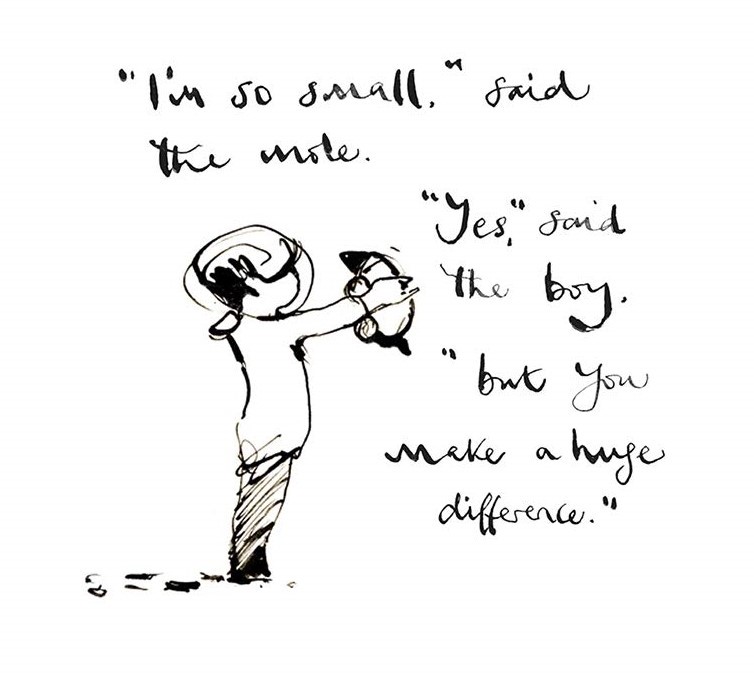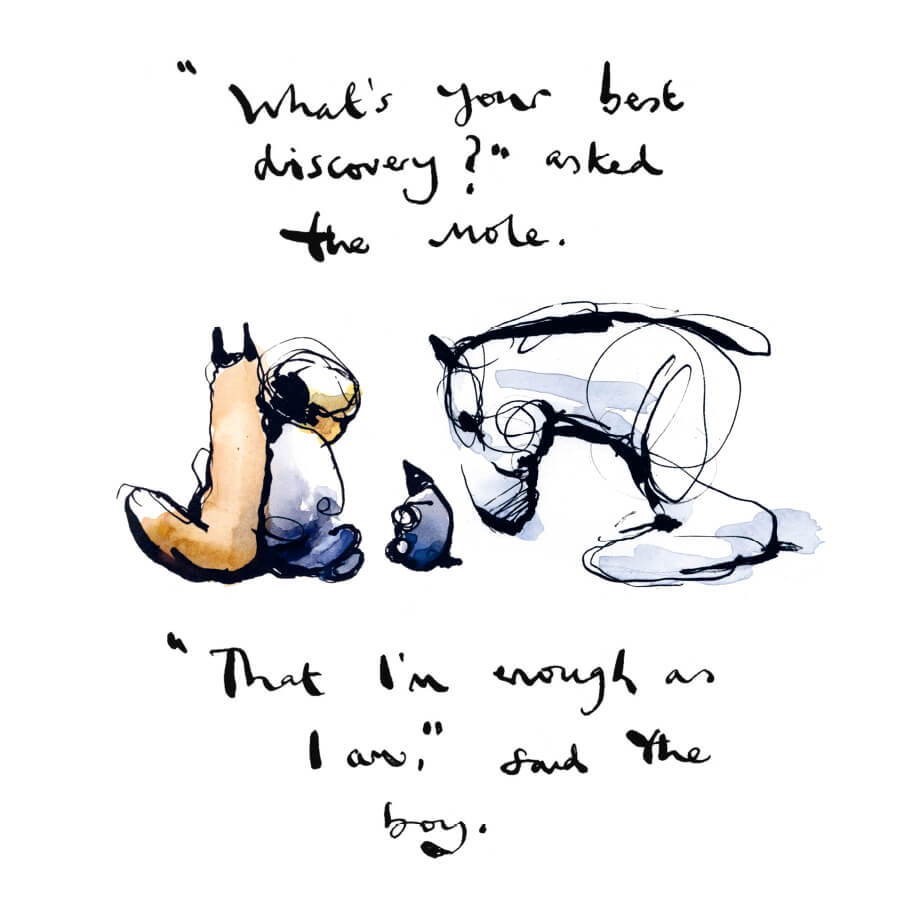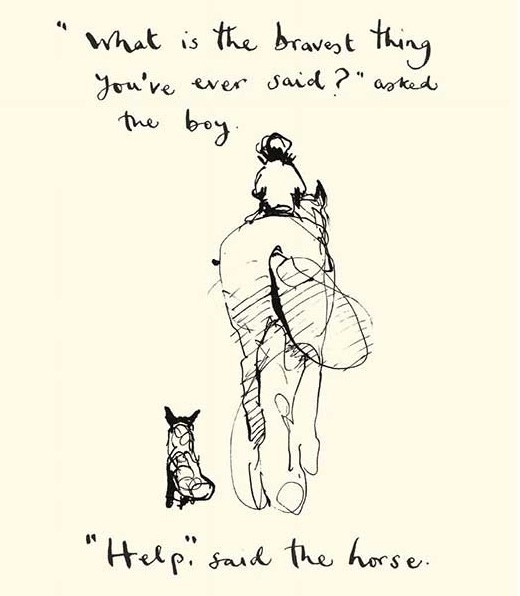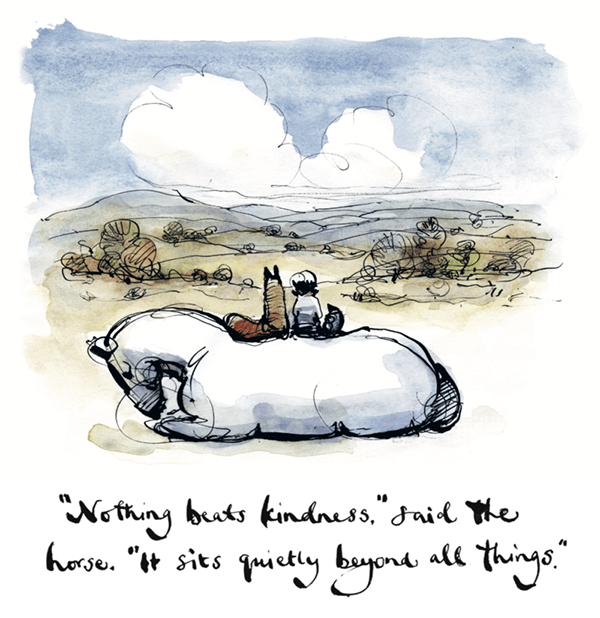Mackesy, Charlie - VM - Jantien van Wageningen
Charlie Mackesy: The Boy, the Mole, the Fox, and the Horse

About Love, Friendship and Kindness
by Jantien van Wageningen
Last year I received this book via a friend and was immediately touched by it. I am not the only one, because since its publication in English in 2019 more than 2 million copies have been sold worldwide. What makes this book so special and why does it appeal to so many people, young and old?
On the drawing of the beautiful cover we see a horse with his head bent towards a boy, who in turn holds a mole in his hands, with the tail of a fox on his foot. In this picture Mackesy conveys the message of this book: a plea for love, solidarity and friendship. The hand-written letters change from black to gold, which enhances the message they convey: the viewer/reader intuitively feels that it concerns precious wisdom for life, worthy of being discovered and shared.
A lonely boy meets a mole. They stroll through the wilderness that is both frightening and yet beautiful. Then they meet a fox, caught in a trap. The mole saves him, and they continue together. They meet the horse who is big and wise and learn that they are allowed to be vulnerable and discover the power of love. This is the story in brief, but in essence it is about the conversations, about how they think about life and their relationship with each other.


‘One picture is worth a thousand words,’ according to a well-known saying. In the foreword of the book Mackesy expresses it like this: ‘The truth is that I need pictures. They are like islands, places we can go to in a sea of words.’ Pictures function as refuge. Here speaks an artist who, as no other, can convey atmosphere, feelings, and moods in his sketchy, simple drawings. They are made in black and white ecoline ink, sometimes coloured in. Often they simply consist of lines with many thickenings. The boy’s face is never actually seen, the animals are sketched roughly, often accompanied by a text of dialogues.
The pictures and words connect seamlessly with each other, as on the page with the drawing of the boy on the horse, with the fox alongside, seen from behind. ‘What is the most courageous word you have ever said?’ the boy asked. ‘Help,’ answered the horse – he probably dared to say that because he did not have to look at the boy.

All the characters have their own personalities with their own strengths and weaknesses. They are each concerned with different matters. The boy is curious and asks many questions. The mole really loves cake. The fox is quiet because he is hurt by life. The horse is wise and kind-hearted. Snippets of open conversations arise, in which they share their vulnerability, fears, desires and dreams. As they do so, they look at each other or they look together at their surroundings. In this way reciprocity is born in which the one needs the other and also allows him his own worth.
.jpg)
‘I hope that this book encourages you, perhaps, to live without fear and with more kindness for yourself and for others,’ writes Mackesy in his foreword, nourished by what he has experienced in his own life: ‘I try to distil and simplify those things that I have learned in life into these little characters. Let’s hope that someone will benefit from them.’
‘Try to spread your wings and follow your dreams – this book is one of mine.’
‘Life is difficult – but you are loved.’
‘So, you know everything about me?’ the boy asked.
‘Yes,’ said the horse.
‘And you still love me?’
‘We love you all the more because of that.’
This message of unconditional love seems to appeal to many. Everyone can give their own interpretation to the texts because they concern universal values that are important for each human being. A Christian will recognise a hopeful gospel, in which Jesus calls us to love each other and live a merciful life: ‘You are loved, just as you are.’ Or, as Mackesy said in one of his interviews: ‘Jesus Christ taught me to consider human beings very beautiful.’

*******
Charlie Mackesy: The Boy, the Mole, the Fox and the Horse, Ebury Press, 2019.
Charlie Mackesy (1962) is a British artist and author. The Boy, the Mole, the Fox and the Horse has sold more than 2 million copies worldwide and was in the top ten for 55 weeks in the Sunday Times Bestsellers List. His book was chosen as the Waterstones Book of the Year 2019 and was on the shortlist for the British Book Awards in 2020. Mackesy grew up in Northumberland in the north of England and went to a boarding school when he was seven. He lives in London and in Suffolk, where, together with his sister, he cares for his mother. He has lived and painted in South-Africa, Sub-Saharan Africa, and the United States. Mackesy was a cartoonist for The Spectator and an illustrator for Oxford University Press. He also collaborated with Richard Curtis for Comic Relief, a UK charity promoting a just world free from poverty. He is a former atheist who 'found Jesus.’ He sees his work as a way to ‘present God to the people he loves.' Many of his paintings have a religious theme. He was selected to work on the Unity Series-project of Nelson Mandela, whereby he gave renewed form to the drawings that Mandela had made. Mackesy regularly speaks at Holy Trinity Brompton Church in London, where Alpha Courses started and developed.
An interview with Mackesy: https://www.youtube.com/watch?v=GjV9MX_LmdI&list=RDCMUCVT1tPkR-fUVlO652EcO3ow&start_radio=1&t=0&ab_channel=CBSSundayMorning
Jantien van Wageningen was lecturer in Dutch language and literature at Hogeschool Windesheim in Zwolle, the Netherlands, until her retirement.
ArtWay Visual Meditation August 15, 2021


